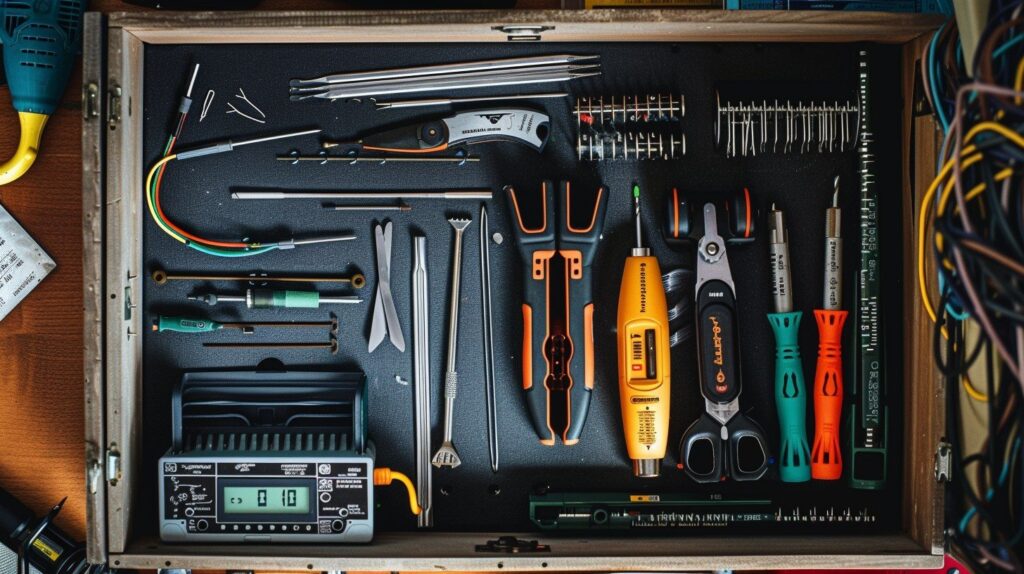Discover the must-have plastering tools that separate amateur attempts from flawless professional results – your complete guide to mastering the art of perfect plastering.
Understanding the Foundations of Professional Plastering
In the world of professional plastering, having the right tools isn’t just about convenience—it’s essential for achieving those pristine, flawless finishes that distinguish expert craftsmanship from amateur attempts. Recent industry surveys indicate that over 85% of professional plasterers attribute their superior results to using the correct, high-quality tools. As experienced plasterers in Kent, we’ve learned that investing in proper equipment not only enhances the quality of work but also significantly improves efficiency and project outcomes. In this comprehensive guide, we’ll explore the essential tools every professional plasterer needs, from basic mixing equipment to specialized finishing implements.
Core Mixing and Preparation Tools
The foundation of any successful plastering job lies in proper mixing and preparation. Studies show that approximately 40% of plastering issues stem from incorrect mixing techniques or inadequate preparation tools. Essential mixing equipment includes:
- Mixing Bucket: Invest in heavy-duty, graduated buckets specifically designed for plaster mixing, typically 25-30 litre capacity
- Power Mixer: A professional-grade drill (minimum 850W) with paddle attachment for consistent mixing results
- Mixing Stand: A sturdy mortar stand to keep your mix at an ergonomic height, reducing back strain
- Gauging Trowel: For accurate measurement of mixing quantities
- Clean Water Source: Essential for achieving the right consistency
For larger commercial projects, consider investing in a mechanical plaster mixer, which can increase productivity by up to 60% compared to manual mixing methods.
Primary Application Tools: The Plasterer’s Arsenal
The application phase requires a carefully selected set of tools that enable smooth, efficient plastering. Your primary toolkit should include various trowels and application implements, each serving a specific purpose in achieving that perfect finish. Modern stainless steel trowels have shown a 25% improvement in durability compared to traditional variants.
- Finishing Trowel: Both stainless steel and carbon steel options, with sizes ranging from 11′ to 14′
- Hawk: Lightweight aluminium or traditional wooden design for holding plaster
- Float: Various types including wooden, plastic, and sponge for different finishing techniques
- Darby: Essential for levelling larger wall areas
- Corner Trowel: For achieving clean, sharp internal corners
Surface Preparation and Finishing Equipment
Proper surface preparation directly impacts the final result, with industry data showing that 70% of plastering failures are attributed to inadequate surface preparation. Essential equipment for this crucial phase includes scarifiers for creating the perfect key, straight edges for achieving perfectly level surfaces, and specialized finishing tools. Modern carbon fibre straight edges have revolutionised the industry, offering improved accuracy and reduced weight compared to traditional aluminium tools.
Access and Safety Equipment
Working at height requires specific equipment to ensure both safety and quality results. Recent health and safety statistics indicate that proper access equipment can reduce workplace accidents by up to 65%. Essential height access tools include:
- Plastering Stilts: For reaching heights up to 1.2m safely
- Hop-Ups: Sturdy platforms for medium-height work
- Platform Towers: For larger commercial projects
- Safety Equipment: Including non-slip footwear and appropriate PPE
Maintenance and Cleaning Tools
Tool maintenance is crucial for longevity and consistent results. Professional plasterers who follow proper maintenance routines report up to 40% longer tool life compared to those who don’t. Essential maintenance equipment includes wire brushes, cleaning buckets, and specialised cleaning solutions. Daily cleaning routines should be established to prevent plaster from hardening on tools, which can significantly impact their effectiveness.
Specialist Tools for Advanced Techniques
For achieving superior finishes and tackling complex projects, professional plasterers require specialised tools. The latest market research shows that contractors with comprehensive specialist tool kits secure 30% more high-end projects. These advanced tools include:
- Angle Beads and Snips: For perfect external corners
- Specialty Finishing Trowels: Including Venice and Japanese trowels for decorative finishes
- Textured Rollers and Brushes: For creating designed patterns
- Scrim Tape and Applicators: For joint reinforcement
Building Your Professional Tool Kit
Investment in quality tools is crucial for long-term success in plastering. Industry experts recommend allocating 15-20% of your initial business investment to building a comprehensive tool kit. Begin with essential tools and gradually expand your collection as your expertise and project requirements grow. Quality tools, while initially more expensive, typically offer better value over time through improved durability and superior results.
Caring for Your Plastering Tools
Proper tool care is essential for maintaining professional standards and protecting your investment. Research indicates that well-maintained tools can last up to three times longer than poorly maintained ones. Establish a regular maintenance routine including:
- Daily cleaning after use
- Proper storage in dry conditions
- Regular inspection for wear and damage
- Immediate replacement of damaged tools
- Application of protective coatings where appropriate
Making the Right Investment in Your Plastering Future
Success in professional plastering relies heavily on having the right tools and maintaining them properly. Industry statistics show that professionals who invest in quality tools see a return on investment within 6-12 months through improved efficiency and higher-quality results. Remember, your tools are not just equipment—they’re an investment in your craft and your future success. By carefully selecting and maintaining your plastering tools, you’re setting yourself up for consistent, professional-grade results that will satisfy even the most discerning clients in Kent and beyond.
FAQ
Why is plastering so difficult?
One of the reasons plastering can be such a difficult skill to master is the required pace of the application. Plaster needs to be applied fast and smooth, to prevent the plaster from setting before it’s properly smoothed out. This is something most people get better at with practice.
Can you plaster a room in a day?
The average room takes around 1 – 3 days to plaster in most cases. Plastering is a very popular choice for finishing walls and making sure they are ready for paint and wallpaper, but if you’re planning your own room or house renovation project, you may be wondering how long it takes to plaster a room.
What is the best trowel for beginner plastering?
Arguably, stainless steel trowels remain the best trowel for applying the first few coats of plaster so we recommend every plasterer’s tool kit includes a stainless steel trowel. Plastic plastering trowels are a fantastic addition if you are looking for a top-quality finish.
Sources
[1] https://walltools.com/tools-equipment/plaster/
[2] https://www.krafttool.com/plaster
[3] https://marshalltown.com/pro-3937-plastering-trowels

